#kavieng
Photo



New type of Jellyfish by Scuba Ventures - Kavieng
36 notes
·
View notes
Text

A bomber banks away after dropping its load on a Japanese submarine chaser off Kavieng, Papua New Guinea. January 1942.
34 notes
·
View notes
Text
RE-APPOINTED TREASURER LING-STUCKEY COMMITS TO GET ECONOMY WORKING BETTER FOR THE PEOPLE
Hon. Ian Ling-Stuckey, CMG. MPMinister for Treasury and Acting Minister for Finance24 June 2024
P O Parliament HouseWaigani. NCDm: +675 71111777 On behalf of my people of Kavieng, and the Pangu Pati, I welcome my re-appointment as Treasurer as well as Acting Minister for Finance, in the Marape-Rosso Government” stated Ian Ling-Stuckey at a Mamaday Forum in Kavieng, for ward 14 mother’s of south…

View On WordPress
0 notes
Text
Sismo de magnitude 6,0 sacode águas de Papua Nova Guiné
Um sismo de magnitude 6,0 foi esta segunda-feira registado no mar de Bismarck, a leste da Papua Nova Guiné, disseram as autoridades, que não relataram vítimas ou danos materiais.

O abalo ocorreu às 11h05 (02h05 em Portugal continental) no mar, com o hipocentro localizado a dez quilómetros de profundidade, de acordo com o serviço geológico dos Estados Unidos (USGS), que regista a atividade sísmica em todo o mundo.
A cidade mais próxima do local é Kavieng, capital da província da Nova Irlanda, a 224 quilómetros do epicentro.
0 notes
Text
USGS | M 6.0 - 72 km SSW of Kavieng, Papua New Guinea https://earthquake.usgs.gov/earthquakes/eventpage/us7000jhw8/executive
0 notes
Photo

schöner Fisch by galleria-fovi
#underwater diving#kavieng#water sports#powder blue surgeonfish#diver#fusilier fish#saltwater#swimmin
10 notes
·
View notes
Text
My Pupu (grandmother) harvesting Aupa (greens) from her garden in Kavieng, New Ireland. She fries them up with garlic or steams them and sprinkles chicken stock powder on top.
0 notes
Photo


Day 28: Nights adrift on the Bismarck Sea
The Bismarck Sea has been (almost) just ours to sail for the past ten days, island-hopping around the insular provinces of PNG. I haven’t posted updates for a while as there is no data, electricity, etc etc here…
Every few days another ship’s in sight on the horizon. No earth other than atolls and islands where meeting villagers and exchanging dry food for fruits, stories, dances and life tips.
After a not-so-serene night in the bay of Kavieng we left early for New Hannover where we chose the small island of Ungalabu to spend a day and a night. Hermit Island kept us longer and as it was difficult to leave we had to skip Ninigo on the way to Indonesian Papua.
Now Vanimo’s in sight, last city before the changing border with Indonesia. That’s where we’ll clear formalities for leaving PNG, then clear in at Jayapura tomorrow morning.
Recorded over and underwater much of last night, under a cristal clear milky way; at the bottom of a sky full of new constellations cassiopea’s upside down. I also have tons of jungle sounds from Hermit Island: bamboos, rats, spiders, ants and reefs.
The Bismarck Sea’s very calm and deep blue, when no shark seems to be around we swim over 2500m of darkness and unknown. Some parts are "undocumented", grey on the map: as no cargo ever uses these routes no one needs to know what’s underneath. Sometimes birds take a break on our boat to rest... or die.
1 note
·
View note
Text
Sooo... jellyfish.
You may have seen this video circulating recently. The original was posted on Facebook by Scuba Ventures Kavieng; this is a colour-corrected edit [link to the original in the post source, because Tumblr is stupid about external links]. It caused a small stir on the internet after being tentatively identified as Chirodectes maculatus, a monotypic genus known only from a single small specimen captured and filmed in 1997, off the coast of Queensland. (That footage is sadly not available on the Internet.)
If you know a little about jellies, you’ll recognise this as a box jellyfish or Cubozoan. Box jellies are wonderfully interesting animals, and differ from the more familiar “true jellyfish” or Scyphozoa in a number of ways:
a more developed nervous system allowing more complex behaviour, including the capacity to learn from experience
true eyes (with retinas, corneas, lenses, the whole shebang)
the ability, unlike true jellies which mostly drift, to actively propel themselves around obstacles and towards prey
...a concerning trait in an animal most notorious for being extremely fatal to humans. (c.f. Wasp Jellyfish, Viper Jellyfish, the delightfully named Common Kingslayer, Irukandji*) * sting symptoms include excruciating pain and “a feeling of impending doom”, and let’s raise a glass to the researcher who first documented Irukandji syndrome by deliberately testing it on himself, a lifeguard, and his nine-year old son: “Eschewing animal models and laboratory studies (not to mention all common sense), Barnes took the two specimens, and proceeded directly to human experimentation.” please read the article linked in my reblog, it’s hilarious. (A lack of self-preservation is a trait apparently common to all jellyfish scientists - the 2005 article on Chirodectes maculatus notes that it failed to sting, or adhere to, the hand and forearm of an incautious volunteer.)
The point is that box jellies are deeply, deeply cool in every respect except basic body plan, which goeth thusly:
box
tentacle on each of the four lower corners
....and while many cubozoans find that four is not enough and multiply to get 4n tentacles, that’s about it. Ultimately, what you end up with is still just a translucent jelly box with string hanging from each corner, like a very sad, very dangerous piñata.
Compare scyphozoans / "true jellies":
[top to bottom: Pacific sea nettles Chrysaora fuscescens aka windows screensaver, barrel jellyfish Rhizostoma pulmo, sea cauliflower Cephea cephea, moon jelly Aurelia aurita, lion's mane jellyfish Cyanea capillata]
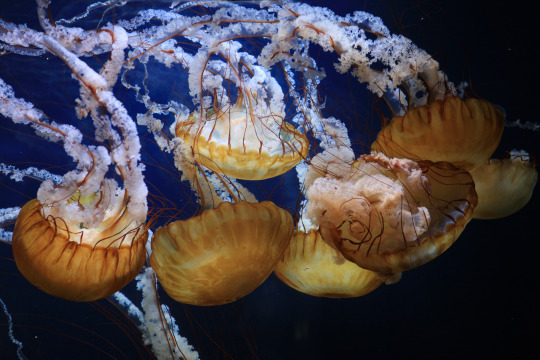
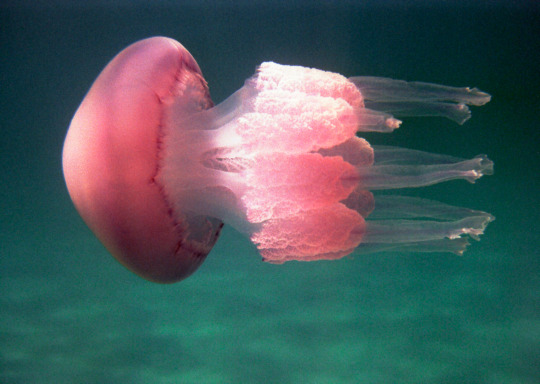

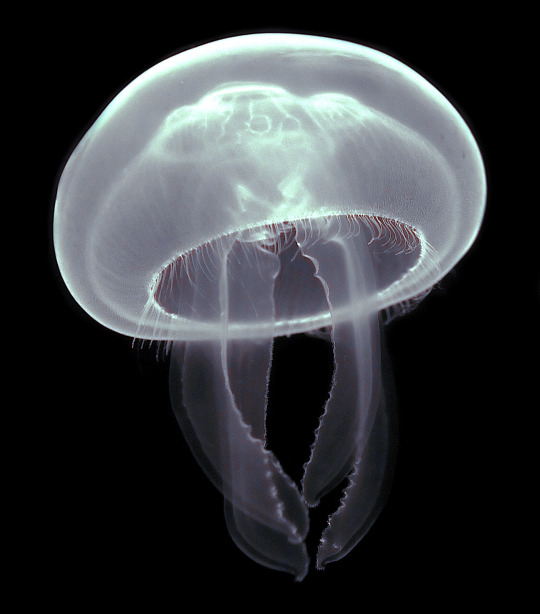

They may not be all that bright, but by god they’re fancy.
Now let's see the box jellies: [Bonaire banded box jellyfish, which rejoices in the name of Tamoya ohboya; sea wasp Chironex fleckeri; Copula sivickisi; Tripedalia cystophora]

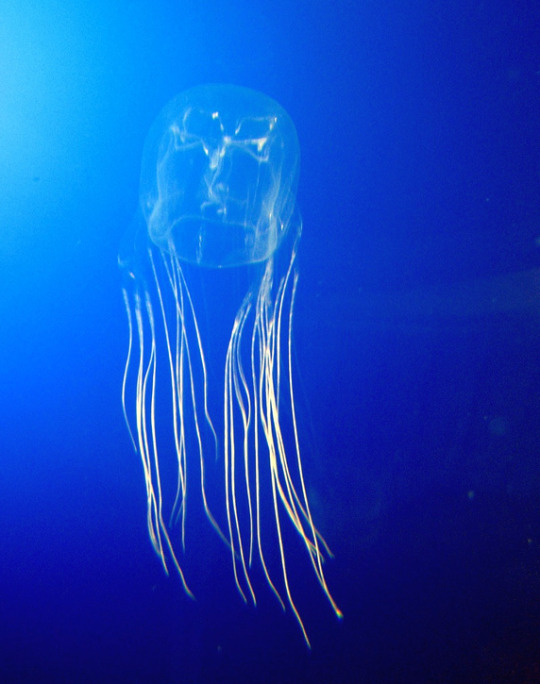
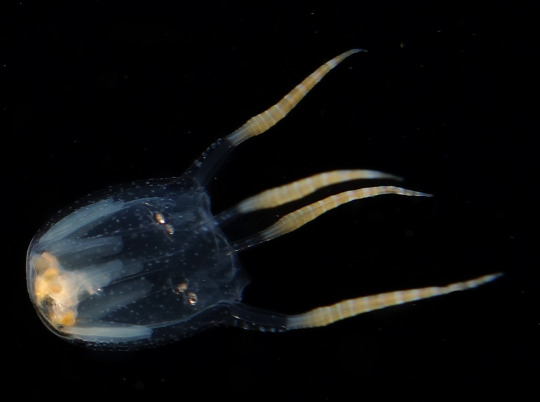

And by cubozoan standards, it is big: according to the diver, "a bit bigger than a soccer ball" (which have a ~21cm diameter), which would make it larger than the 15cm in the original species description.
Where am I going with all this? My point, dear jelly lovers, is that Chirodectes maculatus took a body plan like an inverted plastic bag and made it into the fanciest, most ostentatious chunk of jelly that ever wobbled the seven seas.
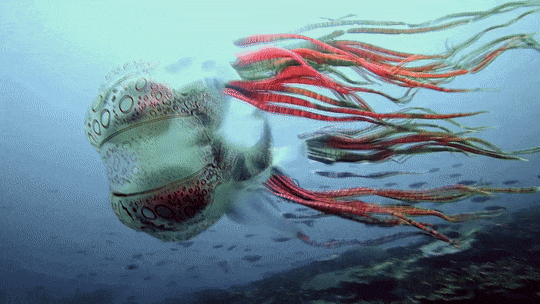
Look at it. It’s like a 1970s lampshade set off to colonise the ocean. And isn't it just fabulous.
Please reblog the linked post for sources and further reading. All images via Wikimedia Commons (licensed with some version of Creative Commons.)
#you may not like it but this is what peak adaptation looks like#there are many benefits to being a marine biologist#being stung by box jellies is not one of them#marine biology#jellyfish#box jellyfish#nature writing#cubozoa#my writings#science!#video
359 notes
·
View notes
Photo

de Havilland DH.86B Express VH-UYW RMA 'Carinthia'. 10 to 12 passenger seating. With WRC Airlines/W.R. Carpenter and Co, based in the Solomon Isles. Pictured in 1938. Ditched into the sea off Kavieng, New Ireland (Papua New Guinea) in 1940
#de Havilland#passenger aircraft#commercial aircraft#civil aircraft#general aviation#airline#WRC Airlines#mailplane#Royal Mail
50 notes
·
View notes
Photo

Japanese seaplanes Mitsubishi F1M2 in the parking lot of the Japanese Kavieng military base
32 notes
·
View notes
Photo

Head, 19th or early 20th century, Brooklyn Museum: Arts of the Pacific Islands
Malangan figure from near Kavieng, New Ireland
Size: 22 3/4 x 6 1/2 x 8 3/4 in. (57.8 x 16.5 x 22.2 cm)
Medium: Wood, fiber, Turbo petholatus opercula, pigment
https://www.brooklynmuseum.org/opencollection/objects/65158
33 notes
·
View notes
Video
undefined
tumblr
This enormous box jellyfish with incredibly rare markings was filmed off PNG by Scuba Ventures Kavieng Discover more wonders of the cosmos at Discover Earth
4 notes
·
View notes
Photo

1944 02 15 Flight out of Hell - Nicolas Trudgian
After three days of continual pounding, the heavily defended Japanese staging base at Kavieng was all but devastated. In the final assault on February 15, 1944, a force ofB-24s, B-25s, and A-20s hammered through a wall of enemy flak between the airfield and the coastline, demolishing everything in their path, but not without cost. Several aircraft were hit by the intense gunfire and by flying debris as fuel dumps exploded, and a number of crews were forced to ditch within clear sight of shore batteries. Three downed B-25 crews from 345th Bomb Group were floating helplessly in life-rafts within a thousand yards of the beach, and with Japanese troops in no mood to take prisoners they knew their only chance of survival was the air-sea rescue PBY Catalina. Flying the "Dumbo" on that fateful day was 28 year old pilot, Lt. Nathan Gordon. Called urgently to the scene, he quickly evaluated the desperate plight of the crews in the water, and, disregarding fire from the shore, put his PBY down in the hail of gunfire no fewer than four times to rescue the stricken airmen. While shells and machinegun fire splashed the water all around his motionless aircraft, Gordon cut his engines so survivors could be hauled aboard.Commemorating one of the most daring air-sea rescues of World War II, "FLIGHT OUT OF HELL" depicts Nathan Gordon's heavily laden PBY Catalina making its final take-off, the intense enemy gunfire from the shore batteries on the island of New Ireland making his mission seemingly impossible. But the young Catalina pilot got all 25 men aboard safely home, and was awarded the Congressional Medal of Honor for what is one of the bravest actions of the war in the Pacific.
74 notes
·
View notes
